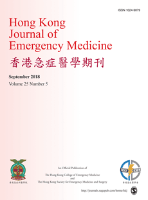
Hong Kong Journal of Emergency Medicine
Scope & Guideline
Advancing Emergency Care Through Knowledge
Introduction
Aims and Scopes
- Clinical Research in Emergency Medicine:
The journal publishes a wide range of original research articles that investigate clinical practices, treatment protocols, and diagnostic methods in emergency settings. - Public Health and Safety:
Research addressing public health issues, including the impact of environmental factors on emergency department visits and the effectiveness of emergency response systems. - Innovative Technologies and Methodologies:
The journal emphasizes studies that explore new technologies and methodologies, such as artificial intelligence in diagnostics and point-of-care ultrasound applications. - Education and Training in Emergency Medicine:
Articles that focus on the education and training of emergency medicine professionals, including the development of curricula and training programs for medical students and residents. - Patient Outcomes and Quality of Care:
Research that evaluates factors influencing patient outcomes, including mortality prediction, risk assessment, and quality improvement initiatives in emergency medicine.
Trending and Emerging
- Impact of COVID-19 on Emergency Medicine:
Research focusing on the effects of the COVID-19 pandemic on emergency care practices, patient demographics, and clinical outcomes is increasingly prevalent, highlighting the need for adaptive strategies in emergency medicine. - Artificial Intelligence and Machine Learning Applications:
There is a growing interest in the application of AI and machine learning within emergency medicine, particularly for diagnostic purposes and predictive analytics, which are becoming critical in enhancing patient care. - Mental Health and Burnout in Emergency Personnel:
Studies addressing the mental health of emergency medicine professionals, including burnout and coping strategies, are gaining traction, emphasizing the importance of psychological well-being in high-stress environments. - Telemedicine and Remote Patient Management:
The rise of telemedicine as a viable option for emergency care is a notable trend, with research exploring its effectiveness in triaging and managing patients remotely. - Innovative Training Methods:
Emerging themes include the exploration of innovative training methods, such as virtual simulation and e-learning, to enhance the educational experiences of emergency medicine practitioners.
Declining or Waning
- Conventional Resuscitation Techniques:
Research focused on traditional resuscitation methods appears to be decreasing, possibly due to the increasing interest in advanced technologies and evidence-based practices. - General Toxicology Studies:
Although toxicology remains a relevant field, the specific focus on general toxicology without immediate clinical application seems to be less prevalent, as more targeted studies on specific substances or syndromes emerge. - Non-Emergency Specific Studies:
There is a noticeable decline in studies that do not directly address emergency medicine, such as those focusing solely on theoretical aspects or non-urgent medical conditions. - Longitudinal Studies in Emergency Settings:
The frequency of longitudinal studies examining long-term outcomes of emergency patients is diminishing, possibly as the field shifts towards more immediate, actionable research. - Epidemiological Studies without Direct Application:
Epidemiological research that does not translate into direct clinical applications or improvements in emergency practices appears to be waning in favor of more applied research.
Similar Journals

Journal of the American College of Emergency Physicians Open
Pioneering Innovations in Emergency Medicine ResearchJournal of the American College of Emergency Physicians Open is a prominent Open Access journal published by WILEY that has been committed to advancing the field of emergency medicine since its inception in 2020. As a vital resource for researchers, clinicians, and students, this journal aims to disseminate innovative research findings, clinical guidelines, and educational resources that support the rapidly evolving landscape of emergency care. With a solid Q1 ranking in the emergency medicine category and positioned within the top 25 ranks of Scopus’ emergency medicine listings, the journal ensures high visibility and accessibility for critical research. As an open-access publication, it provides unrestricted access to its content, facilitating knowledge sharing and collaboration among professionals globally. The journal's significant impact on the field is reflected in its growing influence, underlining its relevance as an essential platform for advancing emergency medicine practice and research.

Eurasian Journal of Emergency Medicine
Elevating standards in emergency care through shared insights.Eurasian Journal of Emergency Medicine is a premier journal dedicated to advancing the field of emergency medicine. Published by GALENOS PUBL HOUSE, this renowned open-access journal has been at the forefront of disseminating critical research and innovative practices since its inception in 2003. With an ISSN of 2149-5807 and an E-ISSN of 2149-6048, it provides a platform for researchers, professionals, and students to share their findings and enhance their understanding of emergency medical practices. The journal's commitment to open access ensures that vital knowledge and research are available to a global audience, promoting collaboration and development within the field. As a valuable resource, the Eurasian Journal of Emergency Medicine plays a pivotal role in shaping contemporary emergency care, addressing pressing issues, and exploring advancements that benefit practitioners and patients alike.

BMC EMERGENCY MEDICINE
Leading the way in emergency medicine scholarship.BMC Emergency Medicine is a premier, open-access journal that has been at the forefront of the field of emergency medicine since its inception in 2001. Published by BMC in the United Kingdom, this journal is distinguished by its impact factor and remarkable Q1 ranking in emergency medicine, placing it among the top-tier publications in this vital area of healthcare. With a current Scopus rank of #30 out of 109 in the category of Emergency Medicine, and occupying the 72nd percentile, BMC Emergency Medicine is a leading platform for researchers and practitioners alike to disseminate their findings related to urgent and critical care. The journal embraces a broad scope within emergency medicine, encouraging submissions on a wide range of topics including clinical practice, innovative techniques, public health, and policy issues that critically affect emergency care. The open-access model ensures that high-quality research is readily available to the global community, fostering collaboration and advancing knowledge in the field. For those dedicated to improving patient outcomes in emergency settings, BMC Emergency Medicine represents an invaluable resource and community.
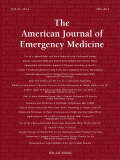
AMERICAN JOURNAL OF EMERGENCY MEDICINE
Elevating Standards in Emergency Medical ResearchThe American Journal of Emergency Medicine, published by W B Saunders Co-Elsevier Inc, stands as a premier platform for the dissemination of high-quality research in the field of emergency medicine. With the ISSN 0735-6757 and E-ISSN 1532-8171, this esteemed journal features contributions that shape clinical practices and enhance patient care in urgent medical scenarios. Since its inception in 1983, the journal has garnered a notable Q1 ranking in Emergency Medicine and a Q2 ranking in Medicine (miscellaneous) for 2023, reflecting its significant impact in the field, as denoted by its Scopus rank of 12 out of 109, placing it in the 89th percentile. Researchers and practitioners alike benefit from the rigorous peer-review process, ensuring that only impactful studies are published, even as the journal maintains a non-open access model, allowing for selective availability of pioneering research. By fostering academic dialogue and advancing knowledge, the American Journal of Emergency Medicine plays a crucial role in addressing the dynamic challenges faced by healthcare professionals in emergency settings.

Clinical and Experimental Emergency Medicine
Delivering essential knowledge for emergency professionals.Clinical and Experimental Emergency Medicine, published by the SEOUL KOREAN SOCIETY OF EMERGENCY MEDICINE, is a premier Open Access journal dedicated to advancing knowledge and practice within the fields of emergency medicine and emergency nursing. With an ISSN of 2383-4625 and an E-ISSN of 2383-4625, this journal has established itself prominently in the academic community, achieving a notable Q2 ranking in both Emergency Medicine and Emergency Nursing categories in 2023. The journal is committed to providing highly relevant research, innovative clinical practices, and educational resources that address the urgent and evolving challenges in emergency care. With a vision to foster collaboration among researchers, practitioners, and students, it aims to contribute significantly to the body of knowledge that enhances emergency medical services and improves patient outcomes globally. Accepting submissions and offering Open Access since its inception in 2014, the journal is positioned as a key resource for those dedicated to the advancement of emergency medicine.
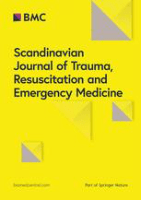
Scandinavian Journal of Trauma Resuscitation & Emergency Medicine
Leading the Charge in Trauma and Emergency InnovationsThe Scandinavian Journal of Trauma Resuscitation & Emergency Medicine, published by BMC, stands as a leading open-access platform dedicated to advancing the fields of trauma, resuscitation, and emergency medicine since its inception in 2008. With an ISSN of 1757-7241 and an impressive track record, this journal has established itself in the top quartile of critical care and emergency medicine, achieving Q1 rankings in both categories for 2023. Its Scopus rankings further underscore its importance, placing it among the top 11 journals in emergency medicine and the 23rd in critical care and intensive care medicine, signaling a strong impact within the academic community. As we converge toward 2024, the journal continues to provide researchers, clinicians, and students with valuable access to cutting-edge research and developments in the sector, contributing significantly to knowledge, practice, and policy in emergency care. Located in the heart of the United Kingdom, the journal remains dedicated to its mission of fostering innovation and dissemination of high-quality research, ensuring that vital medical advancements reach those who need them most.

Resuscitation Plus
Empowering Healthcare Professionals with Open Access InsightsResuscitation Plus, published by Elsevier since 2020, is a leading open-access journal dedicated to advancing the fields of Cardiology and Cardiovascular Medicine, as well as Emergency Medicine and Emergency Nursing. Based in the Netherlands, this scholarly publication aims to disseminate high-quality research, reviews, and clinical practices that enhance patient care and outcomes in resuscitation and critical health situations. Achieving a notable impact factor with Q1 rankings in Emergency Medicine and Emergency Nursing, alongside Q2 in Cardiology, Resuscitation Plus holds a significant position in its respective categories. As an open-access journal, it provides widespread accessibility to vital research findings and discussions, inviting contributions from researchers, healthcare professionals, and academics alike. The journal not only fosters collaboration among the scientific community but also emphasizes the practical application of research to improve emergency health interventions. This convergence of expertise places Resuscitation Plus at the forefront of vital discussions in emergency healthcare.
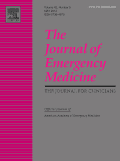
JOURNAL OF EMERGENCY MEDICINE
Driving excellence in emergency medical scholarship.The JOURNAL OF EMERGENCY MEDICINE, published by Elsevier Science Inc, is a premier peer-reviewed journal dedicated to advancing the field of emergency medicine. Since its inception in 1983, this journal has served as an essential resource for researchers, clinicians, and students, contributing significantly to evidence-based practices and innovations in the emergency medical landscape. With an impressive ranking of 43 out of 109 in the field of Emergency Medicine according to Scopus, and a current impact factor placing it in the Q2 quartile, this publication is recognized for its rigorous scholarly content and relevance in tackling contemporary issues in emergency care. Although it does not offer open access, the journal remains widely respected for its contribution to the global emergency medicine community, fostering new ideas and discussions that drive the field forward. For those seeking to stay at the forefront of emergency medical research, the JOURNAL OF EMERGENCY MEDICINE is an invaluable addition to your academic endeavors.
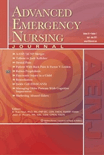
Advanced Emergency Nursing Journal
Shaping the Future of Emergency Medicine TogetherAdvanced Emergency Nursing Journal, published by Lippincott Williams & Wilkins, stands as a key resource within the domains of Emergency Medicine and Emergency Nursing. With a commitment to advancing the field, this journal provides a platform for rigorous research, critical reviews, and innovative practices aimed at enhancing patient care in emergency settings. Though it holds a Q3 ranking in both related categories as per the 2023 metrics, its global reach spans various aspects of emergency care, promising insights that are crucial for both professionals and academics alike. Covering topics from clinical procedures to policy analysis, the journal invites submissions that aim to bridge theory and practice, highlighting the importance of evidence-based approaches in emergency nursing. Researchers, educators, and healthcare practitioners can Find more information and explore their own contributions in a dynamic environment that continuously evolves with the field. Whether you're seeking to stay current with the latest advancements or to publish your findings, this journal is an essential asset for those dedicated to improving care in urgent medical situations.

African Journal of Emergency Medicine
Fostering Collaboration for Better Emergency ServicesAfrican Journal of Emergency Medicine, published by ELSEVIER, serves as a pivotal platform for disseminating innovative research and advancements in emergency medicine and critical care nursing. Launched in 2011, this Open Access journal has quickly garnered attention for its commitment to enhancing healthcare delivery across Africa, catering to a diverse audience of researchers, practitioners, and students. With an impressive rank of #44/109 in Emergency Medicine and positioning itself in the Q2 category for Critical Care Nursing and Emergency Nursing in 2023, the journal has established itself as a significant contributor to the medical community. The journal encourages the submission of high-quality research, reviews, and case reports that can inform clinical practices and emergency protocols across the continent. Its accessibility, reflected by its open access model, ensures that vital findings are available to those who need it most, thus fostering greater collaboration and innovation in emergency healthcare. With a focus on improving patient outcomes and advancing the field, the African Journal of Emergency Medicine is an essential resource for all who are committed to emergency care and related disciplines.